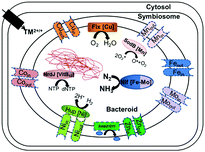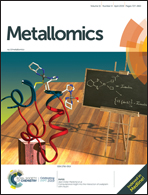Transition metal transporters in rhizobia: tuning the inorganic micronutrient requirements to different living styles†
Abstract
A group of bacteria known as rhizobia are key players in symbiotic nitrogen fixation (SNF) in partnership with legumes. After a molecular exchange, the bacteria end surrounded by a plant membrane forming symbiosomes, organelle-like structures, where they differentiate to bacteroids and fix nitrogen. This symbiotic process is highly dependent on dynamic nutrient exchanges between the partners. Among these are transition metals (TM) participating as inorganic and organic cofactors of fundamental enzymes. While the understanding of how plant transporters facilitate TMs to the very near environment of the bacteroid is expanding, our knowledge on how bacteroid transporters integrate to TM homeostasis mechanisms in the plant host is still limited. This is significantly relevant considering the low solubility and scarcity of TMs in soils, and the in crescendo gradient of TM bioavailability rhizobia faces during the infection and bacteroid differentiation processes. In the present work, we review the main metal transporter families found in rhizobia, their role in free-living conditions and, when known, in symbiosis. We focus on discussing those transporters which could play a significant role in TM-dependent biochemical and physiological processes in the bacteroid, thus paving the way towards an optimized SNF.

- This article is part of the themed collection: Recent Review Articles


 Please wait while we load your content...
Please wait while we load your content...